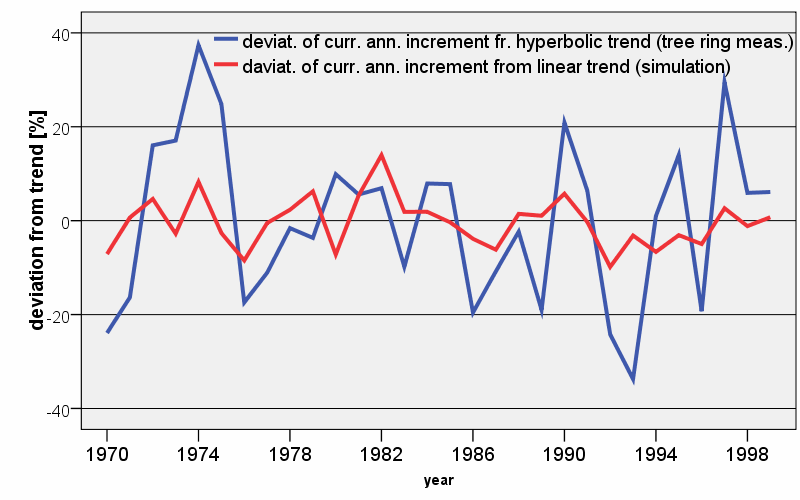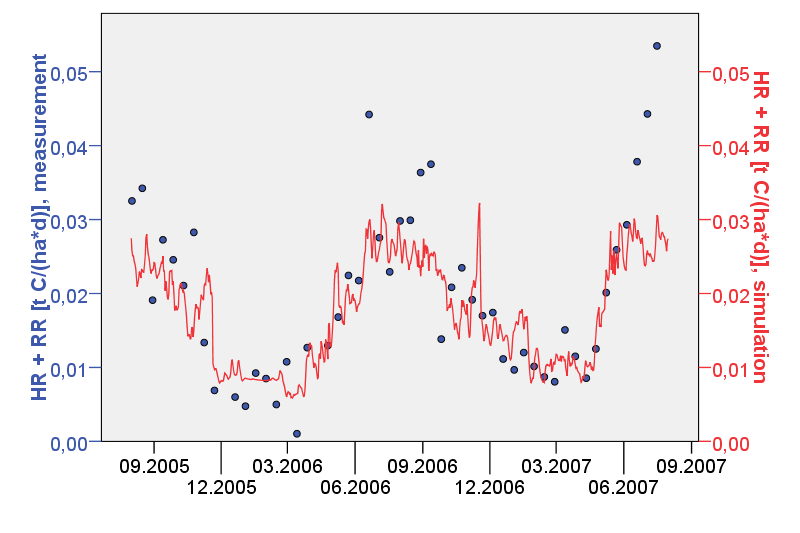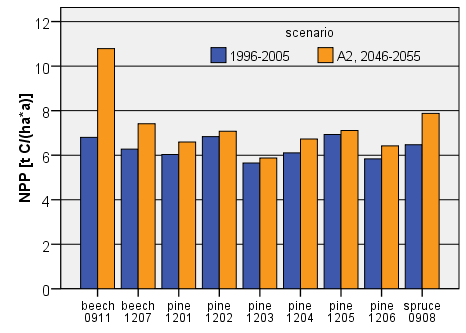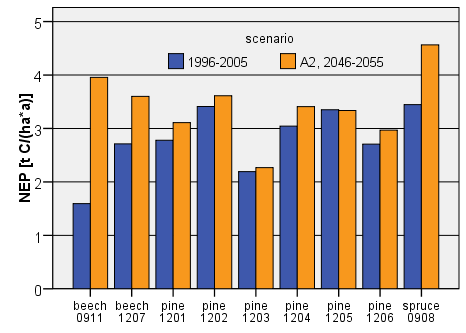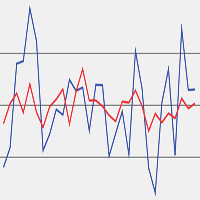
Modelling the carbon budget of intensive forest monitoring sites in Germany using the simulation model BIOME-BGC
iForest - Biogeosciences and Forestry, Volume 2, Issue 1, Pages 7-10 (2009)
doi: https://doi.org/10.3832/ifor0475-002
Published: Jan 21, 2009 - Copyright © 2009 SISEF
Research Articles
Collection/Special Issue: Cost Action E29 Meeting 2008 - Istanbul (Turkey)
Future Monitoring and Research Needs for Forest Ecosystems
Guest Editors: Marcus Schaub (WSL, Birmensdorf, CH)
Abstract
It is shown that by calibrating the simulation model BIOME-BGC with mandatory and optional Level II data, within the ICP Forest programme, a well-founded calculation of the carbon budget of forest stands is achievable and, based on succeeded calibration, the modified BIOME-BGC model is a useful tool to assess the effect of climate change on forest ecosystems.
Keywords
Introduction
The main focus of the intensive monitoring of forests (Level II) within the ICP Forest programme of the UN-ECE is the investigation of effects of atmospheric deposition on element budgets, soil chemistry, crown condition, and tree growth of forest ecosystems. Investigations on forest carbon budget are limited to the sampling of stem increments within a 5 years interval. In a limited number of stands some supplementary measurements are carried out concerning the above and below ground carbon turnover.
The aim of this study was the assessment of additional measurements (litter fall, permanent girth measurement, tree ring analyses, soil respiration, long term development of soil carbon, soil physics, soil moisture) to improve the initialization, calibration and validation of dynamic simulation models with respect to the carbon budget of forest ecosystems. The validated simulation models can be applied for the assessment of the impact of climate change on the carbon budget of forests.
Methods
Sixteen German Level II plots with Fagus sylvatica (3), Pinus sylvestris (8) and Picea abies (5) were selected, where the measurements of the mandatory and optional programmes (meteorology, stand precipitation, soil moisture, deposition, soil solution, soil chemistry, stem biomass (5 years cycle), stem girth measurements, litter fall, crown condition, foliar analysis) and in some cases data on soil physics, tree ring analyses, and sap flow were available. At these plots soil respiration was measured, additionally ([1]). For differentiation between heterotrophic and root respiration the trenching technique was used ([6]).
In our investigation the data were used for the initialization and calibration of BIOME-BGC version 4.2 ([14] - ⇒ http://www.ntsg.umt.edu/models/bgc/), a simulation model for calculating the energy, water, carbon, and nitrogen budget of biomes. For the purpose of the project the programme code of BIOME-BGC was extended by a forest management module, a multi-layered soil water, C, and temperature module, and a root growth module. The programme code concerning phenology, decomposition, canopy evaporation and transpiration modules was modified. At the present status the model shows a more species and stand specific behavior. The number of ecophysiological model parameters (including management) was enhanced from 37 to 80.
The carbon and water budgets of these 16 Level-II sites were calculated for the simulation period 1996-2005 using meteorological data of the open field measurements of the plots.
For analyzing the effects of climate change, the climate scenarios of the statistical model STAR ([12]) for the DWD stations and the years 2046-2055, based on the SRES emission scenario A2 of the IPCC and the global climate model ECHAM5-MPI-OM were used. For the base and climate change scenarios identical initial model values were used. The climate change scenarios consider the predicted atmospheric CO2 concentrations, too, but did not use changing nitrogen deposition.
Results
Comparisons of simulation results with measurements on stand precipitation, soil moisture, and sap flow demonstrate, that the model BIOME-BGC (including modifications) allows a precise simulation of water budget (not depicted). The same applies to soil temperature.
The long term averages of leaf litter fall and stem growth can be simulated with satisfying precision, if the plot number 906 is disregarded (Fig. 1, Fig. 2). In some stands basal area increment from tree ring analyses are weakly correlated to simulated stem increment, mainly in pine stands on sandy soils of Brandenburg (Fig. 3). The annual variation of measured values of leaf litter fall and stem growth exceeds the annual variation of simulation results.
Fig. 3 - Simulation results compared to measurements: deviation of the measured basal area increment from hyperbolic trend compared to the deviation of the simulated current annual stem increment from the linear trend.
Repeated measurements of soil carbon are only available for two stands (Solling beech and spruce). In these stands, the increasing soil carbon stocks cannot be found in the current simulation results. Instead, a slow decrease is simulated (not depicted).
The seasonality of soil respiration (heterotrophic + root resp.) can be reproduced by the model predictions, with the exception of some peaks in summer (Fig. 4). Major deviations occur if measurements at soil sites with trenched roots are interpreted as heterotrophic respiration and compared to simulation results (not depicted).
Fig. 4 - Simulation results compared to measurements: soil respiration (heterotrophic + root respiration).
Simulations using climate change scenarios showed an increasing productivity (GPP, NPP, stem and leaf growth - Fig. 5). On the other hand, the plant and heterotrophic respiration is rising, too. The carbon sequestration of the stands (NEP) is increased under the climate change scenarios (Fig. 6). Due to reduced precipitation, a weak reduction of evaporation and a considerable reduction of soil water outflow (43 % of base scenario) are predicted (not depicted). Transpiration reacts different depending on tree species and site conditions.
Fig. 5 - Simulated net primary production (NPP) under climate change scenarios compared to the measured climate data.
Fig. 6 - Simulated net ecosystem production (NEP) under climate change scenarios compared to the measured climate data.
Discussion
Correct simulations of hydrology and the soil temperature of the forest ecosystem, as realized in this investigation, are essential preconditions for estimating the carbon budget of forest ecosystems with dynamic simulation models.
Even if simulated leaf litter fall and stem growth more or less agree with measurements, the higher annual variations of observations compared to those of simulations indicates, that the model does not yet consider all essential factors determining stem and leaf growth (e.g., fructification, air pollutants). In case of the plot number 906 successful model calibration is not possible. This is may caused by data errors on driving forces, initial values, or on data for calibration.
The divergent simulation results on development of soil carbon pools compared to measurements may have different causes. First, the spatial heterogeneity of soil carbon leads to a wide range of data ([11], [8]) that complicate model initialization and calibration. Additionally, measurements on coarse woody debris are lacking, and data on root turnover, one of the main input-path of organic matter into the soil, are uncertain. Finally, seed production as a further pathway of organic matter into the litter layer is neglected by the model.
With respect to these uncertainties the additional soil respiration measurements represent valuable data for model initialization and calibration. Measured soil respiration with living roots could be simulated satisfactorily. In contrast, the root trenching technique for separation of root and heterotrophic respiration may produce some artifacts, at least under dry summer conditions. Thus, the latter measurements are an uncertain database for model calibration aiming on separated consideration of root and heterotrophic respiration.
The climate change scenarios applied in this investigation are characterized by rising temperature and atmospheric CO2 concentrations and decreasing precipitation. The application of these climate change scenarios are connected to some artifacts caused by systematic climate differences between the meteorological stations of the national weather service (used for climate change scenarios) and open land stations belonged to Level II plots (used for base scenarios).
The simulation results on climate change effects on water budget with decreasing evaporation and water outflow are in line with other investigations ([5]). The results of higher wood production under climate change conditions are in agreement with analyses on growth trends of the past ([13], [2]) and simulation studies for future development ([10], [4]). Obviously, the simulated rising water stress at some Level II plots is counteracted by the fertilizing effect of rising CO2 concentration. By contrast, a simulation study on pine stands in Brandenburg (Germany) reports reduced productivity ([9]). In Europe different gradients (north-south, altitude, maritime-continental) of forest growth reaction on climate change are expected. In the boreal zone the limiting low temperature effect will be reduced, whereas in the Mediterranean zone the limiting drought effect is expected to be enhanced ([7], [3]).
Conclusions
The monitoring data from the current mandatory and optional Level II programme provide valuable information for calibration of dynamic simulation models for calculating the carbon budget of forest ecosystems. Additionally, the data offer some hints for further model development. By calibrating the simulation model BIOME-BGC with mandatory and optional Level II data, a well-founded calculation of the carbon budget of forest stands is achievable. Furthermore, based on succeeded calibration, the modified BIOME-BGC model is a useful tool to assess climate change effects on forest ecosystems.
Acknowledgements
These results are part of a project that was financially supported by the European Commission, Contract No. Forest Focus - DE 2003/2004 BB 5, DE 2003/2004 BY 4, DE 2003/2004 NI 6.
References
Gscholar
Gscholar
Gscholar
Gscholar
Gscholar
Gscholar
Gscholar
Gscholar
CrossRef | Gscholar
Authors’ Info
Authors’ Affiliation
M Puhlmann
Leibniz-Centre for Agricultural Landscape Research, Eberswalder Str. 84, D-15374 Müncheberg (Germany)
D Berthold
H Schulte-Bisping
Institute of Soil Science and Forest Nutrition, University Göttingen, Büsgenweg 2, D-37077 Göttingen (Germany)
R Kallweit
A Konopatzky
Landesforstanstalt Eberswalde, Alfred-Möller-Str. 1, D-16225 Eberswalde (Germany)
K-J Meiwes
Nordwestdeutsche Forstliche Versuchsanstalt, Grätzelstr. 2, D-37079 Göttingen (Germany)
Corresponding author
Paper Info
Citation
Jochheim H, Puhlmann M, Beese F, Berthold D, Einert P, Kallweit R, Konopatzky A, Meesenburg H, Meiwes K-J, Raspe S, Schulte-Bisping H, Schulz C (2009). Modelling the carbon budget of intensive forest monitoring sites in Germany using the simulation model BIOME-BGC. iForest 2: 7-10. - doi: 10.3832/ifor0475-002
Academic Editor
Marcus Schaub
Paper history
Received: Mar 27, 2008
Accepted: Dec 09, 2008
First online: Jan 21, 2009
Publication Date: Jan 21, 2009
Publication Time: 1.43 months
Copyright Information
© SISEF - The Italian Society of Silviculture and Forest Ecology 2009
Open Access
This article is distributed under the terms of the Creative Commons Attribution-Non Commercial 4.0 International (https://creativecommons.org/licenses/by-nc/4.0/), which permits unrestricted use, distribution, and reproduction in any medium, provided you give appropriate credit to the original author(s) and the source, provide a link to the Creative Commons license, and indicate if changes were made.
Web Metrics
Breakdown by View Type
Article Usage
Total Article Views: 53831
(from publication date up to now)
Breakdown by View Type
HTML Page Views: 44272
Abstract Page Views: 4037
PDF Downloads: 4432
Citation/Reference Downloads: 77
XML Downloads: 1013
Web Metrics
Days since publication: 6175
Overall contacts: 53831
Avg. contacts per week: 61.02
Article Citations
Article citations are based on data periodically collected from the Clarivate Web of Science web site
(last update: Mar 2025)
Total number of cites (since 2009): 13
Average cites per year: 0.76
Publication Metrics
by Dimensions ©
Articles citing this article
List of the papers citing this article based on CrossRef Cited-by.
Related Contents
iForest Similar Articles
Editorials
COST Action FP0903: “Research, monitoring and modelling in the study of climate change and air pollution impacts on forest ecosystems”
vol. 4, pp. 160-161 (online: 11 August 2011)
Research Articles
Local ecological niche modelling to provide suitability maps for 27 forest tree species in edge conditions
vol. 13, pp. 230-237 (online: 19 June 2020)
Research Articles
Spatio-temporal modelling of forest monitoring data: modelling German tree defoliation data collected between 1989 and 2015 for trend estimation and survey grid examination using GAMMs
vol. 12, pp. 338-348 (online: 05 July 2019)
Research Articles
Distribution factors of the epiphytic lichen Lobaria pulmonaria (L.) Hoffm. at local and regional spatial scales in the Caucasus: combining species distribution modelling and ecological niche theory
vol. 17, pp. 120-131 (online: 30 April 2024)
Research Articles
Assessing the carbon sink of afforestation with the Carbon Budget Model at the country level: an example for Italy
vol. 8, pp. 410-421 (online: 02 October 2014)
Short Communications
Dynamic modelling of target loads of acidifying deposition for forest ecosystems in Flanders (Belgium)
vol. 2, pp. 30-33 (online: 21 January 2009)
Short Communications
Ozone flux modelling for risk assessment: status and research needs
vol. 2, pp. 34-37 (online: 21 January 2009)
Editorials
Adaptation of forest ecosystems to air pollution and climate change: a global assessment on research priorities
vol. 4, pp. 44-48 (online: 05 April 2011)
Research Articles
A comparison of models for quantifying growth and standing carbon in UK Scots pine forests
vol. 8, pp. 596-605 (online: 02 February 2015)
Commentaries & Perspectives
Towards a transnational system of supersites for forest monitoring and research in Europe - an overview on present state and future recommendations
vol. 4, pp. 167-171 (online: 11 August 2011)
iForest Database Search
Search By Author
- H Jochheim
- M Puhlmann
- F Beese
- D Berthold
- P Einert
- R Kallweit
- A Konopatzky
- H Meesenburg
- K-J Meiwes
- S Raspe
- H Schulte-Bisping
- C Schulz
Search By Keyword
Google Scholar Search
Citing Articles
Search By Author
- H Jochheim
- M Puhlmann
- F Beese
- D Berthold
- P Einert
- R Kallweit
- A Konopatzky
- H Meesenburg
- K-J Meiwes
- S Raspe
- H Schulte-Bisping
- C Schulz
Search By Keywords
PubMed Search
Search By Author
- H Jochheim
- M Puhlmann
- F Beese
- D Berthold
- P Einert
- R Kallweit
- A Konopatzky
- H Meesenburg
- K-J Meiwes
- S Raspe
- H Schulte-Bisping
- C Schulz
Search By Keyword



